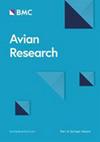Assessing the vulnerability of wintering habitats for the red-listed Asian Houbara (Chlamydotis macqueenii) using climate models and human impact assessments
IF 1.7
2区 生物学
Q1 ORNITHOLOGY
引用次数: 0
Abstract
The Asian Houbara (Chlamydotis macqueenii), a vulnerable species, is under significant threat from habitat degradation and anthropogenic pressures in Pakistan's arid landscapes. This study addresses the urgent need for conservation by identifying critical habitats, analyzing the influence of environmental and human factors on species distribution, and projecting future habitat shifts under climate change scenarios. Using the MaxEnt model, which achieves a robust predictive accuracy (AUC = 0.854), we mapped current and future habitat suitability under Shared Socioeconomic Pathways (SSP126, SSP370, SSP585) for the years 2040 and 2070. Presently, the suitable habitat extends over 217,082 km2, with 52,751 km2 classified as highly suitable. Key environmental drivers, identified via the Jackknife test, revealed that annual mean temperature (Bio1) and slope play a dominant role in determining habitat suitability. Projections show significant habitat degradation; however, under SSP585, highly suitable areas are expected to expand by up to 24.92% by 2070. Despite this increase, vast areas remain unsuitable, posing serious risks to population sustainability. Moreover, only 2115 km2 of highly suitable habitat currently falls within protected zones, highlighting a critical conservation shortfall. These findings highlight the imperative for immediate, targeted conservation efforts to secure the species' future in Pakistan's desert ecosystems.
利用气候模型和人类影响评估评估红色名单亚洲厚原(衣原体)越冬栖息地的脆弱性
亚洲胡原(衣原虫)是一种脆弱的物种,在巴基斯坦干旱的土地上,栖息地退化和人为压力对其构成了重大威胁。本研究通过确定关键生境,分析环境和人为因素对物种分布的影响,预测未来气候变化情景下栖息地的变化,解决了保护的迫切需要。利用MaxEnt模型(AUC = 0.854),绘制了共享社会经济路径(SSP126, SSP370, SSP585)下2040年和2070年的当前和未来栖息地适宜性。目前,适宜生境面积达217,082平方公里,高度适宜生境面积为52,751平方公里。通过Jackknife试验确定的关键环境驱动因素表明,年平均温度(Bio1)和坡度对生境适宜性起主导作用。预测显示生境严重退化;然而,根据SSP585,到2070年,高度适宜的地区预计将扩大24.92%。尽管增加了,但大片地区仍然不适合,对人口的可持续性构成严重威胁。此外,目前只有2115平方公里的高度适宜栖息地属于保护区,这突出了保护的严重不足。这些发现强调了迫切需要立即采取有针对性的保护措施,以确保该物种在巴基斯坦沙漠生态系统中的未来。
本文章由计算机程序翻译,如有差异,请以英文原文为准。
求助全文
约1分钟内获得全文
求助全文
来源期刊

Avian Research
ORNITHOLOGY-
CiteScore
2.90
自引率
16.70%
发文量
456
审稿时长
46 days
期刊介绍:
Avian Research is an open access, peer-reviewed journal publishing high quality research and review articles on all aspects of ornithology from all over the world. It aims to report the latest and most significant progress in ornithology and to encourage exchange of ideas among international ornithologists. As an open access journal, Avian Research provides a unique opportunity to publish high quality contents that will be internationally accessible to any reader at no cost.
 求助内容:
求助内容: 应助结果提醒方式:
应助结果提醒方式:


